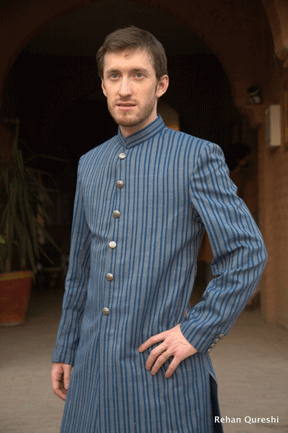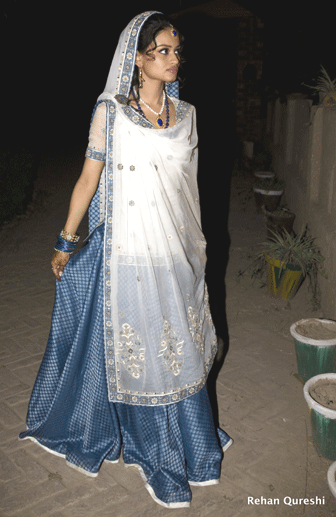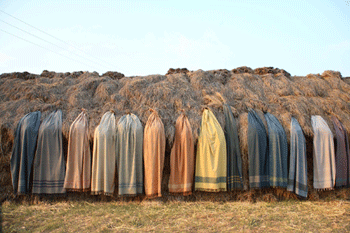I want to prove to the industry that there?s a viable, alternative financial model the world can benefit from. The effect of the clothing industry has more impact on climate change than if the entire world signed the Kyoto Agreement.
Katharine Hamnett , English Fashion Designer
Soon after our Nikah ceremony my husband and I started brainstorming about what our wedding would look like. We wanted the wedding to reflect our values as a couple: we wanted it to be sustainable, socially just and meaningful.
One of my biggest challenges was sustainable materials for our wedding clothes. Ideally I wanted something that was not chemically treated, was local and hand-made (I knew organic cotton would be near impossible to source in the local market so that never made the criteria.) Environmentalist friends and family -ironically- were the first to tell me to snap out of my idealism. Having searched online I found that there are no Pakistani companies dealing with natural dyes: while in Thailand and India there were hundreds. In shops I found some beautiful hand woven, unbleached cotton and silk from India but imported fabric defeated the purpose. Most of our luxury fabrics, like chiffon and silk, come from China. In most cases they are mixed with synthetic threads but sold as “pure” treated with chemicals and dyes that have little regulation when it comes to health, safety or disposal (especially when the manufacturer is Chinese and the consumer is Pakistani).
WWF’s Cleaner Production project helps local manufacturers meet Europe’s stricter environmental guidelines so they can sell in Europe. The environmental impact of the local industry in Pakistan is huge: water pollution from the textile sector accounts for 30 percent of our total BOD emissions.
The World Bank estimates that about 20 percent of industrial water pollution comes from textile dyeing and treatment. There are about 72 toxic chemicals in our water from textile dyeing, 30 of which cannot be removed.
Indigenous Dyes
I contacted a carpet weaving company that used natural dyes but they were unhelpful. I had almost given up when a friend introduced me to KOEL (Noorjehan Bilgrami’s labour of love) as a response to a desperate cry for help on Facebook. Bilgrami’s work and aesthetic was a revelation.
In collaboration with the Government of Sindh, she cultivated an indigenous species of the natural dye indigo, (Indigoferra Tinctoria) at Miani Forest. KOEL had earlier started the use of natural dyes, including natural indigo and madder, all locally produced. Their major work, along with hand-woven materials, was traditional embroideries with master artisans – giving me an alternative to the more glitzy and gaudy bridal outfits I saw everywhere.
On a return trip from Karachi, my mother sent me photos of some KOEL fabrics. I fell in love with one of them in particular: the two shades of indigo, the vibrancy, the life of the color with the small gold “tilla” embossed in the middle of each motif. There is a texture, a beauty, a colour to these fabrics that cannot be experienced until one touches or wears them. KOEL’s embroideries were exquisite and traditional.
A few days later another friend introduced me to Salman Malik in Lahore: He was a godsend with a story to tell and an education to give. We decided to create the dresses in collaboration with KOEL.
Salman Malik had already worked with traditional weavers in various parts of Punjab, helping revive their craft and introduced a line of handwovens called Aangan. He followed this up with a Masters in Fashion Design from the US and found himself working on 7th Avenue with some of the top brands America offered, from custom couture bridals to clothing lines created by popstars: interestingly juxtaposed with his interest and education in Islamic Art.
The State of the Industry
Salman’s experiences offered many stories, with great quips:
“The socks from Pakistan have to match the t-shirt from China: that?s just how it is.”
Original samples sent have to be identical to shipments received later, or risk rejection so much for the ebb and flow of natural dyes then!
Economic growth has also come to depend on continued marketing of new products and disposal of old ones that are thrown away simply because stylistic norms promote their obsolescence. Entire factories all over the developing world are set up and shut down overnight.
Mystics & Weavers
For Salman, the time to return to his weavers in Punjab had come. He came back to Lahore and founded LAL Earth. New York was bad for his health, both spiritual and physical.
“Weaving is mystical, the way a fabric comes together is nothing short of magic,” he told me. Salman had learnt about natural dyes from carpet weavers in Turkmenistan: that?s one industry where natural dyes are widely used. Wool absorbs them well. “Most natural dyes, like madder, grow in the wilderness,” Salman says. “And we have destroyed our wilderness in Pakistan”.
Those that have survived are the botanicals or roots used in “hikmat” or Islamic medicine. Many are imported from Afghanistan. The situation of the availability of natural dyes serves as a barometer of the environmental degradation that Pakistan is going through.
LAL Earth finds it difficult to compete in the local, or international, market.
“Natural dyes are unpredictable” he says. “Indigo, for example may give a completely different blue from season to season, crop to crop, area to area: the indigo of Sindh is not the indigo you may find in Punjab. The pigments are alive. They may change colour or come out different on another fabric”.
Imagine this in an industry where the slightest variation in colour can make a world of difference.
The Human Factor
“A weaver’s family member may die or get sick and you have stopped production for many days? he adds. The human factor alters the game altogether.
“He won?t work if he is stressed or depressed. You cannot treat a human like a machine which can produce hundreds of yards a day: It takes a weaver many days to complete a yard. Cotton weavers are very very skilled and trained and work at will, like artisans. That makes child labour or exploitation impossible. You pay the weaver a significant cost of the final product: the employee and seller are partners.” This of course makes hand-wovens more socially just.
This is the forefront of the conflict between nature and industry; the contrast between man and machine; and the different socio-economics of industrialisation and more traditional systems.
The Root Problem: The Consumer
The root problem may be the consumer.
“The biggest problem for LAL Earth is finding a market, we struggle immensely to survive,” says Salman. “The Pakistani consumer is not interested in a traditional product or how eco-friendly it is”.
The local market is also turning to cheaper, perceivably more fashionable, synthetic materials: like nylon and polyester. The manufacture of these is an energy-intensive process requiring large amounts of fossil fuels, releasing emissions including volatile organic compounds, particulate matter, and acid gases (both into air and as waste waster), all of which can cause or aggravate respiratory and other diseases. Salman remembers the child of one of his friends: dressed from head to toe in polyester, it was obvious he was allergic to it. Nothing surprising for those suffering from skin sensitivities.
Shockingly though, the parents simply refused to do anything about it because the clothes were the “latest fashion, from the US”.
Custom-made. Recycled. Couture
Salman does custom-made couture. The LAL Earth line, founded with business partner Farid Malik of LAL Fabrics also has off-the-rack contemporary kameezes and non-stitched pieces. He also created two recycled dresses for me from my mother and grandmother’s outfits. LAL Earth and KOEL fabrics were used for my husband’s and my family’s wedding outfits. Everything was cheaper than what I would have normally spent: outrageously expensive isn?t exactly sustainable.
There was nothing more rewar-ding than having my friends and family come up to me and tell me that the dress was beautiful and unique. Brides-to-be wanted to make a sustainable dress as well. Knowing I had made a small difference made my day truly special.
This article is dedicated to Saira from KOEL, Naghma Durrani and Naumana Amjad









I am very interested in hearing more about the textile and whether I could use it in my own designs. Great article. My website gives a sense of what I do. Jane